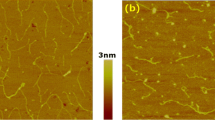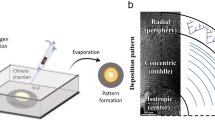Abstract
The supramolecular organisation of collagen adsorbed on polymer substrates was investigated as a function of properties of the substrates (chemical nature, roughness) and of characteristics of the collagen solution (concentration, state of aggregation) as well as details of the preparation procedure (adsorption time, drying rate). Elongated structures are formed at the interface by assembly of collagen molecular segments protruding into the solution. This is favoured by using a hydrophobic and smooth substrate, by increasing the adsorbed amount and by increasing the adsorption time, even beyond stages at which the adsorbed amount does no longer vary. Collagen adsorbed at low amount on hydrophobic substrates strongly reorganises into a net-like pattern if drying is performed at low rate. This is due to dewetting and collagen displacement by the water meniscus. Applications derived from the control of collagen organisation are presented. Nanostructured polymer surfaces were created starting from a collagen template. The attachment and the cytoskeletal organisation of mammalian cells (MCF-7/6) were also shown to depend on collagen organisation.
Similar content being viewed by others
References
T. A. Horbett, B. D. Ratner, J. M. Schakenraad and F. J. Schoen, in “Biomaterials Science: An Introduction to Materials in Medicine”, edited by B. D. Ratner, A. S. Hoffman, F. J. Schoen and J. E. Lemons (Academic Press, 1996) p. 133.
J. L. Brash and T. A. Horbett, in “Proteins at Interfaces II: Fundamentals and Applications”, edited by T. A. Horbett and J. L. Brash (ACS Symposium Series 602, 1995) p. 1.
K. Kadler, Protein Profile 1 (1994) 519.
F. Grinnell, S. Nagakawa and C.-H. Ho, Exp. Cell Res. 182 (1989) 668.
Ch. C. Dupont-Gillain, B. Nysten and P. G. Rouxhet, Polymer Int. 48 (1999) 271.
Y. F. Dufréne, T. G. Marchal and P. G. Rouxhet, Langmuir 15 (1999) 2871.
Ch. C. Dupont-Gillain, Ph.D. Thesis, Université catholique de Louvain, Louvain-la-Neuve, Belgium (2000).
Ch. C. Dupont-Gillain and P. G. Rouxhet, Langmuir 17 (2001) 7261.
Ch. C. Dupont-Gillain and P. G. Rouxhet, Nanoletters 1 (2001) 245.
V. M. De Cupere and P. G. Rouxhet, Surf. Sci. 491 (2001) 395.
F. A. Denis, P. Hanarp, D. S. Sutherland, J. Gold, C. Mustin, P. G. Rouxhet and Y. F. Dufréne, Langmuir 18 (2002) 819.
Ch. C. Dupont-Gillain and I. Jacquemart, Surf. Sci. 53 (2003) 145.
V. M. De Cupere, J. Van Wetter and P. G. Rouxhet, Langmuir 19 (2003) 6957.
E. Pamula, V. M. De Cupere, Y. F. Dufréne and P. G. Rouxhet, J. Colloid Interface Sci. 271 (2004) 80.
I. Jacquemart, E. Pamula, V. M. De Cupere, P. G. Rouxhet and Ch. C. Dupont-Gillain (2003) submitted.
Ch. C. Dupont-Gillain, Y. Adriaensen, S. Derclaye and P. G. Rouxhet, Langmuir 16 (2000) 8194.
K. J. Payne and T. A. King, Biopolymers 25 (1986) 1185.
J. Gross and D. Kirk, J. Biol. Chem. 233 (1958) 355.
L. Chang, T. Kious, M. Yorgancioglu, D. Keller and J. Pfeiffer, Biophys. J. 64 (1993) 1282.
A. Curtis and C. Wilkinson, Biochem. Soc. Symp. 65 (1999) 15.
J. T. Elliott, A. Tona, J. T. Woodward, P. L. Jones and A. L. Plant, Langmuir 19 (2003) 1506.
Author information
Authors and Affiliations
Corresponding author
Rights and permissions
About this article
Cite this article
Dupont-Gillain, C.C., Pamula, E., Denis, F.A. et al. Controlling the supramolecular organisation of adsorbed collagen layers. Journal of Materials Science: Materials in Medicine 15, 347–353 (2004). https://doi.org/10.1023/B:JMSM.0000021100.71256.29
Issue Date:
DOI: https://doi.org/10.1023/B:JMSM.0000021100.71256.29




